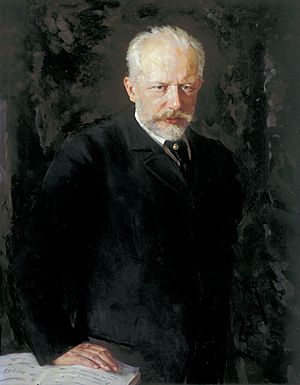1812 Overture facts for kids
The 1812 Overture is a famous piece of music written by Pyotr Ilyich Tchaikovsky. It's an orchestral work, which means it's played by a large group of musicians. Tchaikovsky wrote it to celebrate a big moment in Russian history.
This music remembers when Russia defended itself in 1812. This was during the French invasion of Russia, when Napoleon's huge army, called the Grande Armée, tried to take over. A very important battle was the Battle of Borodino.
The 1812 Overture was first played for everyone to hear on August 20, 1882. This special event happened at the Cathedral of Christ the Saviour in Moscow. People often remember this music for its exciting sounds, especially the loud cannon fire and ringing bells at the end.
Contents
What Instruments Are Used in the 1812 Overture?
The 1812 Overture is played by a full orchestra. An orchestra has many different kinds of instruments. Here are the instruments Tchaikovsky wrote for in this piece:
Woodwind Instruments
Brass Instruments
Percussion Instruments
- Timpani (kettle drums)
- Bass Drum
- Snare Drum
- Cymbals
- Tambourine
- Triangle
- Carillon (a set of bells)
- Cannons (yes, real ones!)
Other Sections
- A Brass Band (a group of brass instruments)
- Strings:
- Violins (first and second)
- Violas
- Violoncellos
- Double basses
Special Addition
- Heavy Artillery: Real Cannons are used for the powerful ending!
The Story the Music Tells
The 1812 Overture tells the story of the French invasion of Russia through music. It even has 16 cannon shots written into the music!
How the Music Begins
The piece starts with a sad, prayer-like tune. It's a Russian Orthodox song called "God Preserve Thy People." It's played by eight cellos and four violas, making a deep, serious sound.
The Battle and Retreat
As the music continues, you hear a mix of peaceful country sounds and exciting battle sounds. A Russian folk dance tune, "At the Gate, at my Gate," is also part of the music. When the story reaches the Battle of Borodino, which was a major turning point, the music calls for five Russian cannon shots.
After this, the strings play a tune that goes down, showing the French army retreating. Then, you hear sounds of victory bells and the "God Preserve Thy People" tune again, but this time it sounds triumphant. This part of the music also shows Moscow burning, which the Russians did to stop the French from using their buildings for winter.
The Victory and Anthem
The music then has a fast, exciting part, like a chase. Out of this, the old Russian national anthem, "God Save the Tsar!", appears. Tchaikovsky used a musical idea called a leitmotif for the Russian forces. This idea is repeated and woven into the music to show Russia's strength.
It's interesting to know that "God Save the Tsar!" was Russia's national anthem when Tchaikovsky wrote the music. But it wasn't the anthem back in 1812. Russia didn't have an official national anthem until 1815.
Different Versions of the Overture
Some recordings of the 1812 Overture have special changes. An American conductor named Igor Buketoff made a version with these additions:
- The opening part, "God Preserve Thy People," is sung without instruments by a choir.
- A children's or women's choir sings along with the flute and English horn when they play "At the Gate."
- At the very end, the orchestra and choir join together. They play a powerful version of "God Preserve Thy People" and "God Save the Tsar."
Images for kids
See also
 In Spanish: Obertura 1812 para niños
In Spanish: Obertura 1812 para niños



